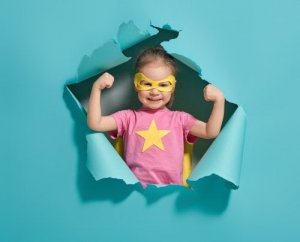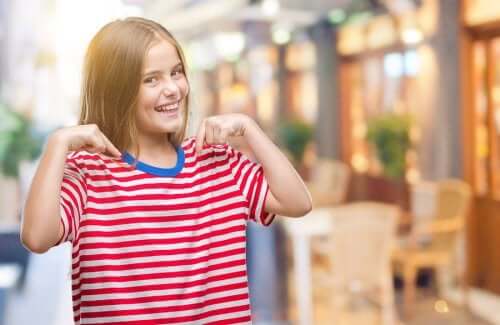The Backpack of Positive Qualities


Written and verified by the psychologist Ana Couñago
Maximizing the self-esteem of little ones is a fundamental part of their proper development. To help do this, you can use certain exercises, such as the Backpack of Positive Qualities. Below, we’ll tell you all about this interesting activity.
But first, you should know that self-esteem refers to a person’s valuation of him or herself on the basis of subjective qualities. This self-assessment depends on the experiences a person has lived, his or her self-perception, and the perception of others.
Therefore, it’s important that children, from the very beginning of their lives, experience love and acceptance from those closest to them.
“A child needs encouragement like a plant needs water.”
– Rudolf Dreikurs –
The Backpack of Positive Qualities: improving children’s self-esteem
The backpack of positive qualities consists of reliving different experiences, feelings, and thoughts. The purpose of this exercise is to bring to light and value those strengths and weaknesses that one possesses, placing emphasis on positive qualities and characteristics. This is what will go into the imaginary backpack that children will carry around with them for the rest of their lives.

The main objective of this exercise is to manage to improve and boost children’s self-esteem. Furthermore, this personal reflexion activity helps children acquire the following capacities:
- Self-evaluation
- Self-awareness
- The ability to recognize one’s own qualities
- The ability to express one’s own thoughts and feelings
- Self-confidence
- The ability to accept oneself unconditionally
“To love oneself is the beginning of a lifelong romance.”
– Oscar Wilde –
The Backpack of Positive Qualities
In order to carry out this activity, you’ll need to follow a series of steps below:
- Give children a drawing of a backpack and several small pieces of paper. The papers should be blank and circle-shaped in order to look like rocks.
- On each of these papers, children should write down positive and negative qualities about themselves.
- Then, children should stick these qualities onto the drawing of a backpack.
- Once children are at this point, explain that they need to get rid of some of these rocks because their backpack is too heavy.
- Now, the children can cross out the negative qualities – the ones they want to get rid of.
- Finally, they color in the positive qualities to highlight them and give them greater importance.
All of these steps are necessary in order to guide children in the process of:
- Self-reflection
- Self-awareness
- Self-assessment
- Self-acceptance
In other words, these steps are a key part of a child’s development and the creation of healthy self-esteem.

The origin of childhood self-esteem
It’s important to remember that the origin of self-esteem lies in the social environment where children relate. And, more concretely, in the bonds that they establish with those people closest to them. This includes family, friends, professors, etc. These bonds have a significant influence on the development of low or high self-esteem.
So, children perceive their qualities according to:
- The interpretations that others make regarding their behaviors and conducts.
- Information that others transmit regarding their virtues and defects.
- The way in which others treat them – especially their loved ones.
Therefore, with this in mind, we can conclude that carrying out the Backpack of Positive Qualities isn’t enough to raise a child’s self-esteem. Rather, this activity is a mere tool that serves to help.
However, what’s most important and necessary is encouraging and paying attention to children every day. It’s making them feel valued and loved.
“Parents need to fill a child’s bucket of self-esteem so high that the rest of the world can’t poke enough holes to drain it dry.”
– Alvin Price –
Maximizing the self-esteem of little ones is a fundamental part of their proper development. To help do this, you can use certain exercises, such as the Backpack of Positive Qualities. Below, we’ll tell you all about this interesting activity.
But first, you should know that self-esteem refers to a person’s valuation of him or herself on the basis of subjective qualities. This self-assessment depends on the experiences a person has lived, his or her self-perception, and the perception of others.
Therefore, it’s important that children, from the very beginning of their lives, experience love and acceptance from those closest to them.
“A child needs encouragement like a plant needs water.”
– Rudolf Dreikurs –
The Backpack of Positive Qualities: improving children’s self-esteem
The backpack of positive qualities consists of reliving different experiences, feelings, and thoughts. The purpose of this exercise is to bring to light and value those strengths and weaknesses that one possesses, placing emphasis on positive qualities and characteristics. This is what will go into the imaginary backpack that children will carry around with them for the rest of their lives.

The main objective of this exercise is to manage to improve and boost children’s self-esteem. Furthermore, this personal reflexion activity helps children acquire the following capacities:
- Self-evaluation
- Self-awareness
- The ability to recognize one’s own qualities
- The ability to express one’s own thoughts and feelings
- Self-confidence
- The ability to accept oneself unconditionally
“To love oneself is the beginning of a lifelong romance.”
– Oscar Wilde –
The Backpack of Positive Qualities
In order to carry out this activity, you’ll need to follow a series of steps below:
- Give children a drawing of a backpack and several small pieces of paper. The papers should be blank and circle-shaped in order to look like rocks.
- On each of these papers, children should write down positive and negative qualities about themselves.
- Then, children should stick these qualities onto the drawing of a backpack.
- Once children are at this point, explain that they need to get rid of some of these rocks because their backpack is too heavy.
- Now, the children can cross out the negative qualities – the ones they want to get rid of.
- Finally, they color in the positive qualities to highlight them and give them greater importance.
All of these steps are necessary in order to guide children in the process of:
- Self-reflection
- Self-awareness
- Self-assessment
- Self-acceptance
In other words, these steps are a key part of a child’s development and the creation of healthy self-esteem.

The origin of childhood self-esteem
It’s important to remember that the origin of self-esteem lies in the social environment where children relate. And, more concretely, in the bonds that they establish with those people closest to them. This includes family, friends, professors, etc. These bonds have a significant influence on the development of low or high self-esteem.
So, children perceive their qualities according to:
- The interpretations that others make regarding their behaviors and conducts.
- Information that others transmit regarding their virtues and defects.
- The way in which others treat them – especially their loved ones.
Therefore, with this in mind, we can conclude that carrying out the Backpack of Positive Qualities isn’t enough to raise a child’s self-esteem. Rather, this activity is a mere tool that serves to help.
However, what’s most important and necessary is encouraging and paying attention to children every day. It’s making them feel valued and loved.
“Parents need to fill a child’s bucket of self-esteem so high that the rest of the world can’t poke enough holes to drain it dry.”
– Alvin Price –
All cited sources were thoroughly reviewed by our team to ensure their quality, reliability, currency, and validity. The bibliography of this article was considered reliable and of academic or scientific accuracy.
- Orientados. (s.f). Autoestima: dinámicas. Generalitat Valenciana: Conselleria de Educación, Cultura y Deporte.
This text is provided for informational purposes only and does not replace consultation with a professional. If in doubt, consult your specialist.








